Intel 11th Generation Core Tiger Lake-H Performance Review: Fast and Power Hungry
by Brett Howse & Andrei Frumusanu on May 17, 2021 9:00 AM EST- Posted in
- CPUs
- Intel
- 10nm
- Willow Cove
- SuperFin
- 11th Gen
- Tiger Lake-H
CPU Tests: Office and Science
Our previous set of ‘office’ benchmarks have often been a mix of science and synthetics, so this time we wanted to keep our office section purely on real world performance.
Agisoft Photoscan 1.3.3: link
The concept of Photoscan is about translating many 2D images into a 3D model - so the more detailed the images, and the more you have, the better the final 3D model in both spatial accuracy and texturing accuracy. The algorithm has four stages, with some parts of the stages being single-threaded and others multi-threaded, along with some cache/memory dependency in there as well. For some of the more variable threaded workload, features such as Speed Shift and XFR will be able to take advantage of CPU stalls or downtime, giving sizeable speedups on newer microarchitectures.
For the update to version 1.3.3, the Agisoft software now supports command line operation. Agisoft provided us with a set of new images for this version of the test, and a python script to run it. We’ve modified the script slightly by changing some quality settings for the sake of the benchmark suite length, as well as adjusting how the final timing data is recorded. The python script dumps the results file in the format of our choosing. For our test we obtain the time for each stage of the benchmark, as well as the overall time.
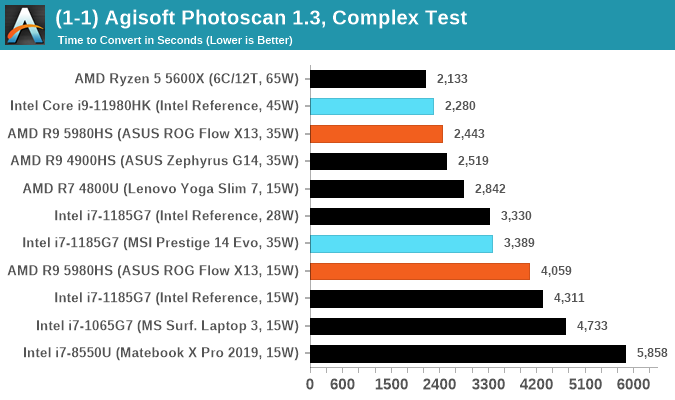
In Agisoft Photoscan, the 11980HK is able to take a large performance leap ahead of the 1185G7 as well as the competition. Intel’s lead here undoubtedly comes also as part of the single-threaded performance advantage it has.
Application Opening: GIMP 2.10.18
First up is a test using a monstrous multi-layered xcf file to load GIMP for the first time. While the file is only a single ‘image’, it has so many high-quality layers embedded it was taking north of 15 seconds to open and to gain control on the mid-range notebook I was using at the time. This test is also the run where GIMP optimizes itself, and the optimization requirements scale linearlly with the number of threads in the system.
What we test here is the first run - normally on the first time a user loads the GIMP package from a fresh install, the system has to configure a few dozen files that remain optimized on subsequent opening. For our test we delete those configured optimized files in order to force a ‘fresh load’ each time the software in run. As it turns out, GIMP does optimizations for every CPU thread in the system, which requires that higher thread-count processors take a lot longer to run. So the test runs quick on systems with fewer threads, however fast cores are also needed.
We measure the time taken from calling the software to be opened, and until the software hands itself back over to the OS for user control. The test is repeated for a minimum of ten minutes or at least 15 loops, whichever comes first, with the first three results discarded.
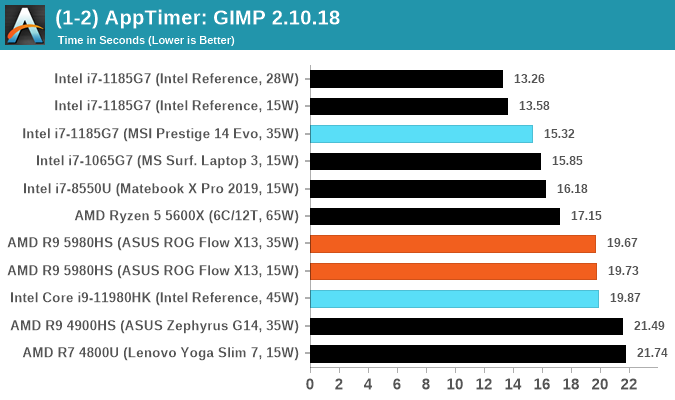
In AppTimer and GIMP, we’re seeing a bit of a weird result for the TGL-H system – I’m not too sure what’s happening here, so it’s something to investigate further once we have more time with the system.
RISCV Toolchain Compile
Our latest test in our suite is the RISCV Toolchain compile from the Github source. This set of tools enables users to build software for a RISCV platform, however the tools themselves have to be built. For our test, we're running a complete fresh build of the toolchain, including from-stratch linking. This makes the test not a straightforward test of an updated compile on its own, but does form the basis of an ab initio analysis of system performance given its range of single-thread and multi-threaded workload sections. More details can be found here.
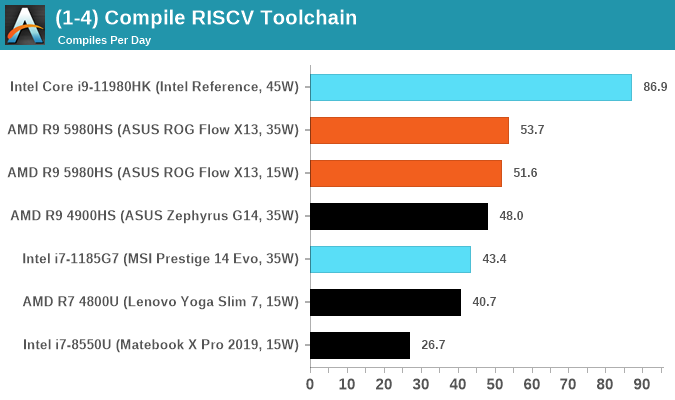
Science
In this version of our test suite, all the science focused tests that aren’t ‘simulation’ work are now in our science section. This includes Brownian Motion, calculating digits of Pi, molecular dynamics, and for the first time, we’re trialing an artificial intelligence benchmark, both inference and training, that works under Windows using python and TensorFlow. Where possible these benchmarks have been optimized with the latest in vector instructions, except for the AI test – we were told that while it uses Intel’s Math Kernel Libraries, they’re optimized more for Linux than for Windows, and so it gives an interesting result when unoptimized software is used.
3D Particle Movement v2.1: Non-AVX and AVX2/AVX512
This is the latest version of this benchmark designed to simulate semi-optimized scientific algorithms taken directly from my doctorate thesis. This involves randomly moving particles in a 3D space using a set of algorithms that define random movement. Version 2.1 improves over 2.0 by passing the main particle structs by reference rather than by value, and decreasing the amount of double->float->double recasts the compiler was adding in.
The initial version of v2.1 is a custom C++ binary of my own code, and flags are in place to allow for multiple loops of the code with a custom benchmark length. By default this version runs six times and outputs the average score to the console, which we capture with a redirection operator that writes to file.
For v2.1, we also have a fully optimized AVX2/AVX512 version, which uses intrinsics to get the best performance out of the software. This was done by a former Intel AVX-512 engineer who now works elsewhere. According to Jim Keller, there are only a couple dozen or so people who understand how to extract the best performance out of a CPU, and this guy is one of them. To keep things honest, AMD also has a copy of the code, but has not proposed any changes.
The 3DPM test is set to output millions of movements per second, rather than time to complete a fixed number of movements.
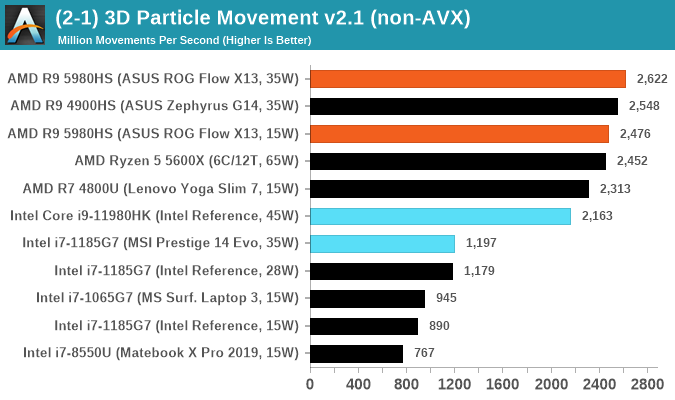
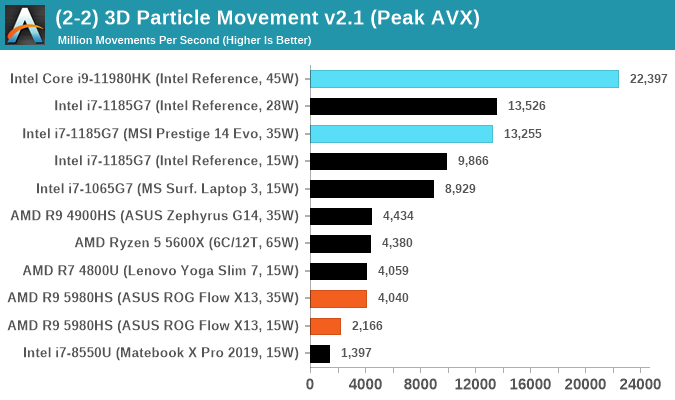
y-Cruncher 0.78.9506: www.numberworld.org/y-cruncher
If you ask anyone what sort of computer holds the world record for calculating the most digits of pi, I can guarantee that a good portion of those answers might point to some colossus super computer built into a mountain by a super-villain. Fortunately nothing could be further from the truth – the computer with the record is a quad socket Ivy Bridge server with 300 TB of storage. The software that was run to get that was y-cruncher.
Built by Alex Yee over the last part of a decade and some more, y-Cruncher is the software of choice for calculating billions and trillions of digits of the most popular mathematical constants. The software has held the world record for Pi since August 2010, and has broken the record a total of 7 times since. It also holds records for e, the Golden Ratio, and others. According to Alex, the program runs around 500,000 lines of code, and he has multiple binaries each optimized for different families of processors, such as Zen, Ice Lake, Sky Lake, all the way back to Nehalem, using the latest SSE/AVX2/AVX512 instructions where they fit in, and then further optimized for how each core is built.
For our purposes, we’re calculating Pi, as it is more compute bound than memory bound. In single thread mode we calculate 250 million digits, while in multithreaded mode we go for 2.5 billion digits. That 2.5 billion digit value requires ~12 GB of DRAM, and so is limited to systems with at least 16 GB.

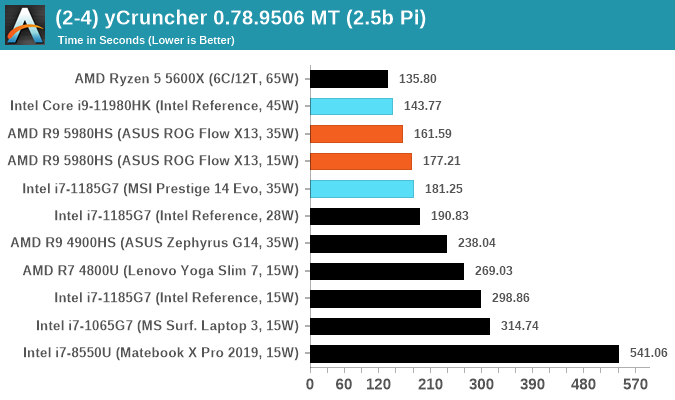
NAMD 2.13 (ApoA1): Molecular Dynamics
One of the popular science fields is modeling the dynamics of proteins. By looking at how the energy of active sites within a large protein structure over time, scientists behind the research can calculate required activation energies for potential interactions. This becomes very important in drug discovery. Molecular dynamics also plays a large role in protein folding, and in understanding what happens when proteins misfold, and what can be done to prevent it. Two of the most popular molecular dynamics packages in use today are NAMD and GROMACS.
NAMD, or Nanoscale Molecular Dynamics, has already been used in extensive Coronavirus research on the Frontier supercomputer. Typical simulations using the package are measured in how many nanoseconds per day can be calculated with the given hardware, and the ApoA1 protein (92,224 atoms) has been the standard model for molecular dynamics simulation.
Luckily the compute can home in on a typical ‘nanoseconds-per-day’ rate after only 60 seconds of simulation, however we stretch that out to 10 minutes to take a more sustained value, as by that time most turbo limits should be surpassed. The simulation itself works with 2 femtosecond timesteps. We use version 2.13 as this was the recommended version at the time of integrating this benchmark into our suite. The latest nightly builds we’re aware have started to enable support for AVX-512, however due to consistency in our benchmark suite, we are retaining with 2.13. Other software that we test with has AVX-512 acceleration.
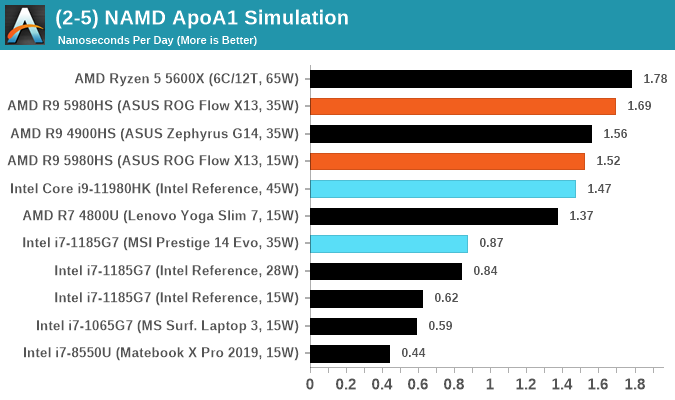
AI Benchmark 0.1.2 using TensorFlow: Link
Finding an appropriate artificial intelligence benchmark for Windows has been a holy grail of mine for quite a while. The problem is that AI is such a fast moving, fast paced word that whatever I compute this quarter will no longer be relevant in the next, and one of the key metrics in this benchmarking suite is being able to keep data over a long period of time. We’ve had AI benchmarks on smartphones for a while, given that smartphones are a better target for AI workloads, but it also makes some sense that everything on PC is geared towards Linux as well.
Thankfully however, the good folks over at ETH Zurich in Switzerland have converted their smartphone AI benchmark into something that’s useable in Windows. It uses TensorFlow, and for our benchmark purposes we’ve locked our testing down to TensorFlow 2.10, AI Benchmark 0.1.2, while using Python 3.7.6.
The benchmark runs through 19 different networks including MobileNet-V2, ResNet-V2, VGG-19 Super-Res, NVIDIA-SPADE, PSPNet, DeepLab, Pixel-RNN, and GNMT-Translation. All the tests probe both the inference and the training at various input sizes and batch sizes, except the translation that only does inference. It measures the time taken to do a given amount of work, and spits out a value at the end.
There is one big caveat for all of this, however. Speaking with the folks over at ETH, they use Intel’s Math Kernel Libraries (MKL) for Windows, and they’re seeing some incredible drawbacks. I was told that MKL for Windows doesn’t play well with multiple threads, and as a result any Windows results are going to perform a lot worse than Linux results. On top of that, after a given number of threads (~16), MKL kind of gives up and performance drops of quite substantially.
So why test it at all? Firstly, because we need an AI benchmark, and a bad one is still better than not having one at all. Secondly, if MKL on Windows is the problem, then by publicizing the test, it might just put a boot somewhere for MKL to get fixed. To that end, we’ll stay with the benchmark as long as it remains feasible.



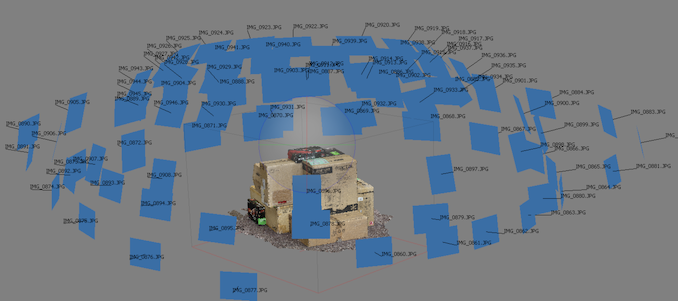

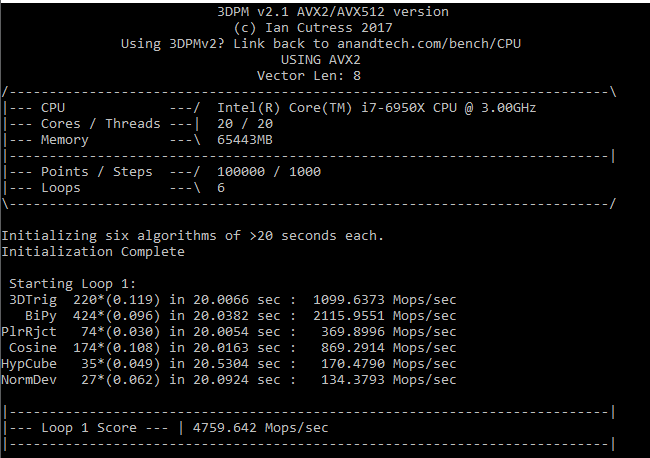

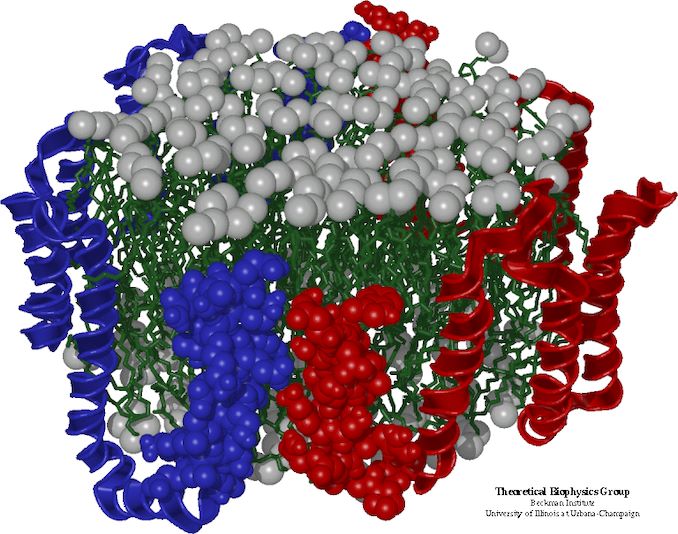









229 Comments
View All Comments
Bagheera - Tuesday, May 18, 2021 - link
Intel isn't gonna have enough EUV in time to ramp 7nm by 2023. they are in serious trouble and floating on borrowed time, most analysts just aren't aware.https://semiwiki.com/forum/index.php?threads/will-...
Intel's 10nm is indeed competitive with TSMC 7nm in terms of density, but AMD will be moving to 5nm with Zen 4 next year, what can Intel's response be? They can increase outsourcing to TSMC but that means less utilization of their own fabs which is bad. They absolutely won't be able to get 7nm ready in time to compete with AMD on TSMC 5nm. It will be back to the status quo of Intel lagging behind AMD by one full node, and likely foregoing power efficiency for performance parity.
Bagheera - Tuesday, May 18, 2021 - link
no actual semiconductor professional expected Intel 10nm to surpass TSMC 7nm in any tangible way. the only people who expected otherwise are uniformed enthusiasts (usually gamers, who the to be partial to Intel)The gap will only widen from here. Intel really shot itself in the foot with bad EUV planning.
https://semiwiki.com/semiconductor-services/ic-kno...
watzupken - Tuesday, May 18, 2021 - link
I feel this review concludes that Intel have effectively lost their competitive edge when their fab started to lag behind. In fact, its also conclusive that the SuperFin is really nothing super at all even when compared to TSMC's 7nm. Its just 10nm on steroids just like what they have been doing to their 14nm. From an architect standpoint, Willow Cove is decent, but the bulk of the performance is due to pushing for very high clock speed at the expense of very high power consumption. If this was released on a desktop, it will be a hit. But on mobile, I don't think one can easily find a laptop that have the cooling capability to tame the heat output and also maintain a decent battery life. Especially this processor will likely be paired with a high end GPU. To me, this is a worrying trend for Intel because they will likely have to stick around with 10nm for another couple of years at least. If their new CPU architect is unable to provide decent IPC gains without bursting the power limit, they will surely be in trouble, especially when AMD's 5nm chips may appear in the market first.mode_13h - Tuesday, May 18, 2021 - link
> If this was released on a desktop, it will be a hit.Yes.
> I don't think one can easily find a laptop that have the cooling capability
> to tame the heat output and also maintain a decent battery life.
At 35 W, it would probably make a fine laptop. Unfortunately, competitive pressure is pushing Intel to juice their CPUs more than they really should.
sandeep_r_89 - Tuesday, May 18, 2021 - link
Can you please please stop using the word BIOS for modern devices? Pretty much all devices have been on UEFI only for several years now.Silver5urfer - Tuesday, May 18, 2021 - link
Ah the M1 fastest CPU ever, doesn't make it to SMT SPEC scores for some reason, like always. Don't worry we will see the Apple CPU which would be X version of the chip iteration when it finally catches up to the SMT of these SMT until then M1 is the best CPU ever.TGL machines will throttle to peak with the thin and light garbage heatsinks. That's a given, people should stop buying these parts. Laptop batteries will be destroyed eventually and none of them will have the Dell Desktop Power plan only Workstations have that feature (Lenovo and Dell), Alienware used to have, not sure about now their A51M R1 and R2 also they had their GFX modules smoke, anyways the battery won't be available for the end user to service and the expensive machine will die and BGA with soldered HW to further limit everything, add the overheating NVMe SSDs due to poor ventilation, happens in Alienware machines too which are targeted as maximum performance.
Spunjji - Thursday, May 20, 2021 - link
🤪🤡😤🤬🤥💩mode_13h - Friday, May 21, 2021 - link
Oof. Looks like *someone* is giving Emojipedia a workout!: )
Spunjji - Tuesday, May 18, 2021 - link
This ended up how I was expecting - superior single-core performance where there's thermal headroom, dropping down to broadly competitive multi-performance at the rated TDP, and with a faintly ludicrous maximum power draw under all-core boost.I'm glad it's competitive. That's needed. What I'm a little less glad about is that we're almost certainly in for another round of CPU performance varying *wildly* between different designs, which has been true to some extent for a while, but getting steadily worse ever since Ice Lake showed up.
Given most OEMs' approach to cooling, I'd wager that the average device shipping with Cezanne will provide better CPU performance than the average device with Tiger 45 simply because of Cezanne's greater efficiency.
tekit - Tuesday, May 18, 2021 - link
Heard they enabled undervolting again for tiger lake-h, can anyone confirm? I wonder how much undervolting potential there is and if that could balance the equation against AMD.